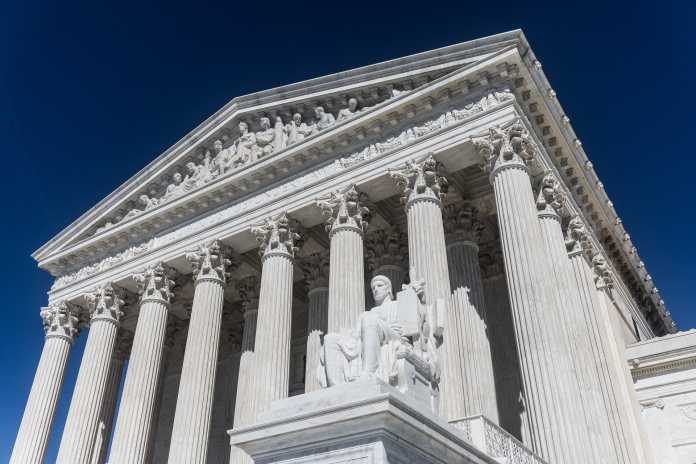The U.S. Supreme Court heard arguments Tuesday on whether federal or state courts should decide the City of Baltimore’s suit against oil companies, in which Baltimore seeks compensation for alleged harms of climate change. Regardless of the outcome, Baltimore should be suing itself, not oil companies, for worsening flooding events caused largely by neglected infrastructure.
National Public Radio (NPR) published an article Wednesday on the suit, while uncritically summarizing climate-activists’ debunked climate-activist talking points on the topic. In short, climate change is not causing “widespread damage” in Baltimore or anywhere else in the country. Most specifically, the science fully contradicts Baltimore’s primary argument – that climate change is worsening rainfall and flooding.
The legal issue that is the catalyst for NPR’s story, “Supreme Court Considers Baltimore Suit Against Oil Companies Over Climate Change,” is whether state courts or federal courts should have jurisdiction over the case. Fighting dozens of lawsuits in multiple states with varying rules of discovery, and which may possibly end up in federal courts anyway, would be more expensive and difficult for oil companies to fight for a number of reasons. Regardless of how the Supreme Court ultimately settles the jurisdictional question, the substantive claims made by Baltimore will remain to be heard. When courts consider the substantive issues, the science will show Baltimore is making numerous claims that don’t merit a hearing based on the data available.
“Baltimore’s 2018 lawsuit paints a picture of a city overwhelmed by global warming. Court filings describe the ‘cascading social and economic impacts’ of climate change in Baltimore, including dramatic increases in flood damage from both rain and sea level rise, increasingly deadly heat waves and massive infrastructure failures exacerbated by extreme weather,” writes NPR.
Some of Baltimore’s claims are simply foolish. For instance, according to NPR, Baltimore points to the urban heat island effect as a result of climate change. The urban heat island effect is, in fact, a well-recognized artifact of urban development itself. Cities like Baltimore are covered by concrete, steel, and glass, which absorb heat during the day and release it slowly at night, becoming “significantly warmer than the surrounding area,” as NPR notes. Parks within cities, and less intensively developed lands within and bordering cities are simply cooler than cities themselves.
Data show neither rainfall nor snowfall have been unusually heavy or severe in Baltimore over the past decade. Indeed, Baltimore has experienced less than average amounts of rainfall during four of the past 10 years, while two of the past 10 years rainfall has hovered near the annual average and the remaining four years have brought above-average rainfall. Concerning snowfall, the story is the same, with snowfall neither increasing (four years above average) nor decreasing (six years below average) significantly since 2010.
If anything, sea level rise within the Chesapeake Bay region (within which Baltimore resides) has been below the average rate of sea-level rise that has occurred since the end of the last ice age.
The U.S. Geological Service (USGS) reports, during the previous interglacial warm period before the last ice age, sea level in the Chesapeake Bay area was 5 to 6 meters higher than its present level, despite no human contribution to climate change. As the ice sheets melted during the present interglacial period, “global sea level rose rapidly, at times reaching rates of 50 millimeters per year (mm/yr)—more than 25 times the average rate over the last century. During the period of abrupt climate change when the modern Chesapeake Bay was formed, sea level rose at roughly three times the present rate,” says USGS.
More recently, USGS reports rates of sea-level rise in Chesapeake Bay range from about 3.2 to 4.7 mm/yr depending on the location, slightly exceeding the reported global average of 3.2 mm/yr. USGS says the reason why sea levels are rising at a faster rate in Baltimore and elsewhere throughout the Chesapeake Bay is due to the high degree of land subsidence. “[B]ecause the land is subsiding; therefore, the Chesapeake Bay area is more vulnerable than many other coastal regions to sea-level rise,” USGS reports.
The land is subsiding due to groundwater withdrawals to quench the thirst of Maryland’s and Virginia’s growing coastal metropolitan populations, not due to oil and gas development. Baltimore is causing its own land subsidence and then blaming oil companies for its own behavior and consequences.
“Estimates of local subsidence from groundwater withdrawal in parts of [Maryland adjacent] Virginia are 1.5 and 3.7 mm/yr for 1979–95 and 1982–95, respectively,” says USGS. This means that as much as 50 percent to 80 percent of “sea level rise” in the region is due to the land sinking, not melting glaciers. “Subsidence is expected to increase with greater withdrawals,” concludes the USGS report.
Baltimore’s political leadership is at fault for the city’s flooding woes. As the city has grown along with increased water withdrawals leading to subsidence, the amount of impervious surface has also increased. However, as NPR notes, maintenance and expansion of the “city’s century-old sewer and stormwater systems,” has not kept pace.
“Baltimore is not a rich city, and finding money to upgrade aging infrastructure is already a struggle. …In recent years, sinkholes have opened under multiple city streets — likely due to a combination of failing pipes and large amounts of precipitation,” writes NPR. However, as shown above, data shows precipitation has not increased. Flooding is a result of increasing amounts of water from channelized streams, impervious building sites, roads, and parking lots flowing into a sewage system that has not been upgraded as the city has grown. Aging pipes are proving inadequate for present-day demographic demands.
Whatever the Supreme Court ultimately decides about whether state or federal court is the appropriate venue for Baltimore’s lawsuit against oil companies, the scientific evidence shows it is the city’s own policies, not an increase in extreme weather events or climate change, that is the cause of the cities flooding woes.


















